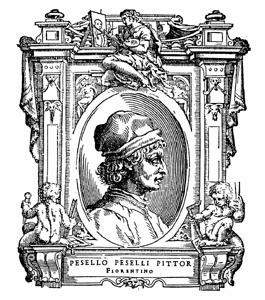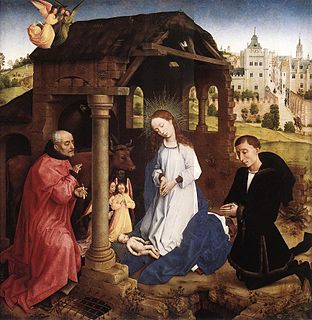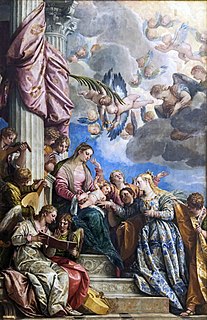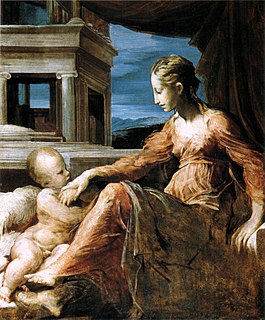
In art, a Madonna is a representation of Mary, either alone or with her child Jesus. These images are central icons for both the Catholic and Orthodox churches. The word is from Italian ma donna 'my lady' (archaic). The Madonna and Child type is very prevalent in Christian iconography, divided into many traditional subtypes especially in Eastern Orthodox iconography, often known after the location of a notable icon of the type, such as the Theotokos of Vladimir, Agiosoritissa, Blachernitissa, etc., or descriptive of the depicted posture, as in Hodegetria, Eleusa, etc.

In Roman Catholic tradition, "Seat of Wisdom" or "Throne of Wisdom" is one of many devotional titles for Mary, the Mother of God. In "Seat of Wisdom" icons and sculptures, Mary is seated on a throne with the Christ Child on her lap. For the more domestic and intimate iconic representations of Mary with the infant Jesus on her lap, see Madonna and Child. The Roman Catholic Church honors Mary, Seat of Wisdom, with a feast day on June 8.
Domenico di Bartolo, born in Asciano, Siena, was a Sienese painter who became active during the early Renaissance period. He was inaccurately named by the famous painter, writer and historian Giorgio Vasari as the nephew of well-reputed Italian artist Taddeo di Bartolo, who is featured in Vasari's Lives of the Most Excellent Painters, Sculptors, and Architects. By the early 1400s, Domenico di Bartolo was one of Siena's artists most influenced by the new Florentine style of painting. During the time that he was active and working, Domenico was the only Sienese painter to have received commissions by clients in Florence. Domenico was also employed by Lorenzo Vecchietta, otherwise referred to as Lorenzo di Pietro, to work alongside him for the fresco The Care of the Sick, which is today considered a masterpiece of the Pilgrim's Hall in the hospital Santa Maria della Scala (Siena).

The Garvagh Madonna is an oil painting by the Italian Renaissance artist Raphael, dating to c. 1509–1510. It depicts the Virgin, the Christ Child and the infant John the Baptist, and is one of many paintings by Raphael with this trio. It is from early in the artist's third, or Roman period, in which distinctive changes are seen from his Umbrian or Florentine period in style and use of colour, with the introduction of more natural subjects and settings.

Giuliano Pesello, born Giuliano d'Arrigo, was an Italian painter of the early Renaissance period, active mainly in Florence. He was a pupil of the painter Andrea del Castagno. Vasari states he painted drawings of animals with skill. He is often called Il Pesello.

Lorenzo di Bicci was an Italian painter of the Florentine School considered to be one of the most important painters in Florence during the second half of the 14th century. He is believed to have learned his trade from his father, about whom little is known. Lorenzo’s style, as well as that of his contemporaries Jacopo di Cione and Niccolò di Pietro Gerini, was influenced by the artist Andrea di Cione. Lorenzo's paintings made use of bright colors and his compositions avoided complexity. The figures he painted tended to have round faces and were often expressionless. Another one of Lorenzo's distinctive characteristics was his precision of execution. He was known for exceptional talent in drawing, an ability that he put to use at the initial stages of his painting. Unlike many celebrated Florentine artists of this period, Lorenzo mostly received commissions from the country clergy and from the lower-middle class Florentine guilds. His successors, Bicci di Lorenzo and Neri di Bicci, continued to serve these groups.

A donor portrait or votive portrait is a portrait in a larger painting or other work showing the person who commissioned and paid for the image, or a member of his, or her, family. Donor portrait usually refers to the portrait or portraits of donors alone, as a section of a larger work, whereas votive portrait may often refer to a whole work of art intended as an ex-voto, including for example a Madonna, especially if the donor is very prominent. The terms are not used very consistently by art historians, as Angela Marisol Roberts points out, and may also be used for smaller religious subjects that were probably made to be retained by the commissioner rather than donated to a church.

Madonna del Prato is a 1505 painting of the Virgin Mary and the Christ Child by Giovanni Bellini, now in the National Gallery in London. Originally painted as oil and egg tempera on wood, it was transferred to canvas in 1949, with damage in places.

Madonna of humility refers to artistic portrayals of the Virgin Mary which depict her sitting on the ground, or upon a low cushion. She may be holding the Christ Child in her lap. The term Virgin of humility is also used to refer to this style of depiction. The iconography originated in the 14th century, and was most common in that and the following century.

The Santa Trinita Maestà is a panel painting by the Italian medieval artist Cimabue, dating to c. 1290-1300. Originally painted for the church of Santa Trinita, Florence, where it remained until 1471, it is now housed in the Uffizi Gallery of Florence, Italy. It represents the Madonna enthroned with the Baby Jesus and surrounded by eight angels and, below, four half portraits of prophets.

The Piccolomini Altarpiece is an architectural and sculptural altarpiece in the left-nave of Siena Cathedral, commissioned by cardinal Francesco Todeschini Piccolomini who expected it to become his tomb. However, he was elected Pope Pius III and buried in the Vatican. It was built between 1481 and 1485 by Andrea Bregno in Carrara marble, with additions in the following decades – these included four niche sculptures produced between 1501 and 1504 by Michelangelo of saints Peter, Augustine, Paul and Gregory. On top of the altar is the Madonna and Child, a sculpture (probably) by Jacopo della Quercia. The central painting of the Madonna is by Paolo di Giovanni Fei and from the late 14th century.

Zanobi di Benedetto di Caroccio degli Strozzi, normally referred to more simply as Zanobi Strozzi, was an Italian Renaissance painter and manuscript illuminator active in Florence and nearby Fiesole. He was closely associated with Fra Angelico, probably as his pupil, as told by Vasari. He is the same painter as the Master of the Buckingham Palace Madonna. Most of his surviving works are manuscript illuminations but a number of panel paintings have also been attributed to him, including seven altarpieces and six panels with the Virgin and Child, along with some designs for metalwork.

Francescuccio Ghissi, also called Francesco di Cecco Ghissi, was an Italian painter. His exact date of birth and death are not known.

Madonna and Child Kissing is a 1520s oil on panel painting by the Flemish renaissance artist Quentin Matsys in the collection of the Rijksmuseum, Amsterdam, on loan to the Mauritshuis.

Madonna and Child with Saints Julian and Lawrence is a c. 1423–1425 tempera and gold leaf on panel painting by Gentile da Fabriano. It is now in the Frick Collection in New York. To the left is saint Lawrence in a deacon's dalmatic and holding the gridiron of his martyrdom, whilst to the right is Saint Julian.

The Mystic Marriage of Saint Catherine is a c.1575 oil on canvas painting by Paolo Veronese, produced as the high altarpiece for Santa Caterina church in Venice. It remained there until the First World War, during which it was moved to its present home in the city's Gallerie dell'Accademia

Madonna and Child with Four Saints or Madonna and Child with Saints John the Baptist, Paul, Mary Magdalene and Jerome is a c. 1516-1520 oil on panel painting by Titian, now in the Gemäldegalerie in Dresden. It belongs to the sacra conversazione genre and features saints John the Baptist, Paul, Mary Magdalene and Jerome.

The Kedleston Madonna is a c.1529 oil on canvas painting by Parmigianino, now in the Kimbell Art Museum in Fort Worth, Texas, which acquired it from the Kedleston collection in the United Kingdom in 1995.

Virgin and Child is an unfinished c.1527-1528 oil on panel painting by Parmigianino, now in the Courtauld Gallery in London. As it is usually identified with one which Giorgio Vasari sketched in Bologna and later bought for himself, it is sometimes also known as the Vasari Madonna. The work passed through unknown hands after Vasari, eventually ending up in Lord Kinnard's collection, from whose successors Antoine Seilern acquired it via Colnaghi in 1965 before bequeathing it to the Courtauld in 1978.

Madonna and Child with Saint Jerome and Saint John the Baptist is a 1492-1495 oil on panel painting by Cima da Conegliano, now in the National Gallery of Art (NGA) in Washington.




















